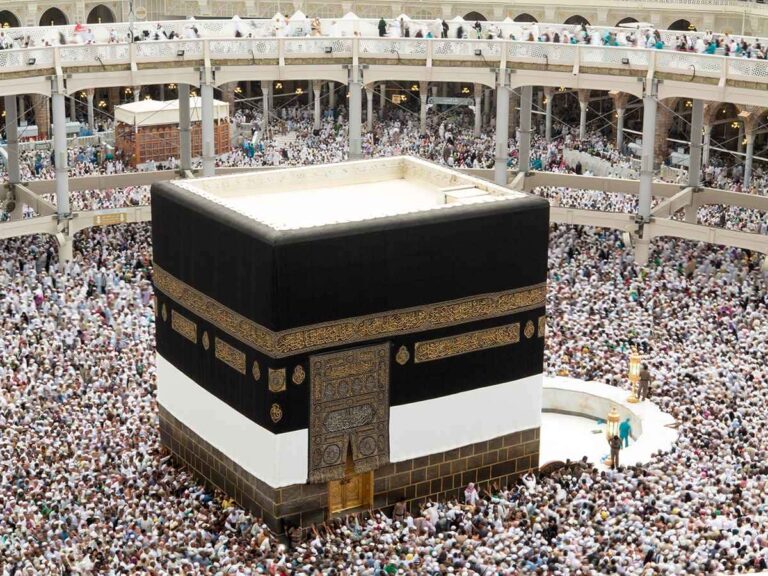The month of Dhul Hijjah brings one of the most significant events of the Islamic Year – Hajj. The Hajj is one of the five pillars of Islam and Muslims from all over the world gather in Makkah to offer this obligation. Here is an overview of what is Hajj and everything you need to know along with a comprehensive Hajj guide.
What is Hajj?
Hajj is the sacred pilgrimage obligated on the Muslims who are Sahib-e-Nisab to be performed at least once in the lifetime. For everyone looking towhat is Hajjit is that time of the year when Muslims gather in Makkah, Saudi Arabia to worship and garner immense rewards through every ritual performed according to Hajj guide.
Hajj begins on every 8th Dhul Hijjah and spans until 4 or 6 days depending on when the moon is sighted for the 12th month of Islamic calendar. Muslims frok all over the world come to perform Hajj following Sunnah of Prophet Ibrahim (AS). This is the reason why is Hajj important to a Muslim.

Interesting Facts About Hajj
As we get to know what is Hajj, there are some of the interesting facts about Hajj as well we as a Muslims should have on finger tips:
- The origins of Hajj goes back to long before the time of Hazrat Muhammad (S.A.W). During Hajj, all those rituals we perform have history linked to 2000 BCE.
- Among all five pillars of Islam, Hajj is the fourth one to be performed in the 12th month of the year.
- Another of the facts of Hajj include the expiation of all the sins of the past years and the year to come according to Hadith.
- Hajj is always performed on 8th Dhul Hijjah.

Hajj 2024: Step By Step Hajj Guide
Now with a handful of information about what is Hajj, it’s time to take a look at Hajj Guide. You can also download hajj guide PDF for better access while performing this obligation
Step 1: Niyyah and Preparation
Prior to reaching Makkah for Hajj, it’s crucial to sincerely intend in your heart to perform the pilgrimage solely for the sake of Allah, seeking spiritual rewards in the hereafter, not for show or material gain.
Step 2: Entering into Ihram
Prepare to enter Ihram, the state of ritual purity. Men should wear the designated white cloth, while women may choose any attire adhering to Hijab rules. Face coverings are not allowed, and closed footwear is prohibited; sandals are required for both genders.
Step 3: Performing Tawaf 7 Times
Tawaf, a key ritual of pilgrimage, entails circling the Kaaba counterclockwise. Each Tawaf consists of seven circuits, beginning and concluding at the Black Stone within the Kaaba. Besides Tawaf, you may offer voluntary prayers to express gratitude to Allah for safe arrival and commence this profound spiritual journey.
Step 4: Safa and Marwa
After completing Tawaf, you’ll proceed to Sa’i, walking and running between Safa and Marwa hills. Starting from Safa, walk towards Marwa, running between designated green markers. Repeat this process for seven laps, alternating between the hills until Sa’i is complete.
Step 5: Trimming or Shaving Head Hair [Umrah Ends]
After finishing Sa’i, men will shave or trim their hair, while women will trim their hair to fingertip length. This signals the end of Umrah, permitting you to exit Ihram until the 8th of Dhul Hijjah.
Step 6: Resting and Praying
After completing Umrah, you’ll remain in Makkah for the remainder of this sacred month to embark on your Hajj journey alongside fellow Muslims. Rest well and utilize your time wisely for sincere worship. Hajj starts on the 8th of Dhul Hijjah.
Step 7: Re-entering the State of Ihram
Embarking on Hajj fulfills a sacred duty, promising a deeply spiritual experience with Allah’s blessings and forgiveness. The journey begins on the 8th day of Dhul Hijjah, marking a new phase in your spiritual path as you purify yourself and enter Ihram once more.
Step 8: Reaching Mina
Upon reaching Mina’s tent city, you’ll find your designated tent and perform Salah, observing Dhuhr, Asr, Maghrib, ‘Isha, and Fajr prayers, reducing four-unit prayers to two units each, as instructed in the Quran. Spend the night in prayer, Quran reading, and preparation for the following day, emphasising spiritual reflection and devotion.
Step 9: Day of Arafah
After sunrise in Mina, you’ll proceed to the plains of ‘Arafah, seeking forgiveness and making supplications on the Day of ‘Arafah. Upon arrival, pilgrims combine shortened Dhuhr and Asr prayers. A sermon is delivered from Masjid al-Nimra, and it’s recommended to listen if feasible, with the possibility of an English translation by your group.
Step 10: Arrival in Muzdalifah
After sunset, leave ‘Arafah for Muzdalifah, where you’ll pray Maghrib and ‘Isha combined, shortening ‘Isha to two Rakat. Rest or worship until shortly before Fajr. Collect pebbles in Muzdalifah for stoning the satin over the next three days. Pebbles should be similar in size to date stones. Gather 49 pebbles, but it’s advisable to have 70 in case some are lost. You can collect extra pebbles in Mina to ensure you have enough for the ritual.
Step 11: Rami and Hady
The 10th of Dhul Hijjah, known as Yawm al-Nahr, marks the Day of Sacrifice. After Fajr Salah, pilgrims leave Muzdalifah for Mina, reciting the Talbiyah. They perform the Hady and start the ‘stoning of the satin’ ritual for three days. Muslims worldwide also offer Qurbani and begin the Eid al-Adha festival.
● Correct Way of Performing Rami
During the 10th, 11th, and 12th days of Dhul Hijjah, you’ll perform Rami (stoning of the satin) using 49 pebbles, each similar in size to date stones or seeds. Divide them into four pouches: 7 for the 10th, and 21 for both the 11th and 12th days. At Jamarat, start by throwing 7 pebbles at Jamarat al-Aqaba while saying “Allāhu ‘Akbar” (Allah is The Greatest).
Step 12: Performing Qurbani and Eid Al-Adha
Eid al-Adha, the Festival of Sacrifice, is observed worldwide by Muslims who are not on pilgrimage on the 10th of Dhul Hijjah. Through Qurbani appeal (sacrifice), Muslims commemorate Prophet Ibrahim’s (AS) obedience to Allah’s (SWT) command to sacrifice his son Isma’il (AS).
Step 13: Shaving the Head
After offering the Hady, men should shave their hair preferably, following the example of Prophet Muhammad (peace and blessings be upon him). Women should trim their hair by the length of a fingertip. You can now exit the state of Ihram, wear comfortable clothes, and resume normal activities except for sexual intimacy. Applying perfume is recommended as Prophet Muhammad (peace and blessings be upon him) did, typically with a scent of musk.
Step 14 & 15: Tawaf al-Ifadha and Saai’
After performing Rami, Qurbani, and shaving (or trimming) your head, you’ll proceed to Makkah for Tawaf al-Ifadha and another Saai circuit, which are obligatory Hajj rituals. Following completion, you can resume lawful activities, including marital relations. However, you’ll return to your tents in Mina to continue with the remaining Hajj rituals.
Step 16: The Second Day of Stoning the Satin
On the 11th of Dhul Hijjah, it’s time for your second day of Rami (stoning of the devil). This time, you’ll throw stones at each of the three pillars in order: Jamarah al-Ula (the small pillar), Jamarah al-Wusta (the middle pillar), and finally, Jamarah al-Aqaba (the large pillar). After the first and second pillars, pause to make Du’a facing the qibla. Each pillar should be hit with seven consecutive pebbles while saying the Takbir. Don’t forget to bring spare pebbles in case you need them!
Step 17: Spending Night in Mina
After completing your second Rami, head back to your Mina camp for the remainder of the day and night, dedicating the time to worship and maximizing its value.
Step 18: The Third Day of Stoning the Satin
On the afternoon of the 12th of Dhul Hijjah, you’ll prepare 21 pebbles and follow the same procedure as the day before.
Step 19: Tawaf al-Wida
Before departing from Makkah, there’s one final step to complete your Hajj: the farewell Tawaf. This Tawaf is obligatory for most schools of thought and must be done before leaving the Haram boundaries. It involves seven laps around the Kaaba, followed by two Rakat of Salah and drinking Zam Zam water. Remember, skipping this Tawaf without a valid reason is not permitted in Islam.
MABROOK!! YOUR HAJJ IS NOW COMPLETE!
For all those preparing to leave for Hajj 2024 or those who are already there, download the Hajj guide PDF by clicking below for your convenience to find out about what is Hajj and the step by step Hajj guide. We wish you all a safe and blessed journey.
While preparing for your Hajj journey, it’s important to stay connected with your daily prayers, no matter where you are. Al-Wahab Foundation provides accurate prayer times for key UK cities, including Manchester prayer times, London prayer times, Birmingham prayer times, and Glasgow prayer times, ensuring you never miss a single Salah. Whether you’re at home or abroad.
As you complete your spiritual journey, take a moment to learn when is ramadan 2026 and prepare to continue your acts of worship and charity in the next sacred month.

